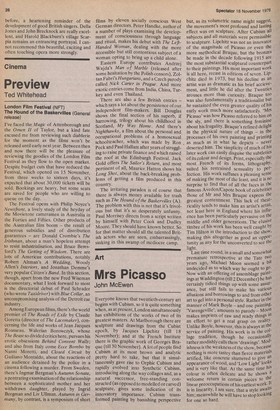Art
Mrs Picasso
John McEwen
Everyone knows that twentieth-century art begins with Cubism, so it is quite something when, as at present, London simultaneously has exhibitions of the works of two of its greatest masters. At Marlborough there are sculpture and drawings from the Cubist epoch, by Jacques Lipchitz (till 18 November); and at the French Institute there is the graphic work of Georges Braque (till 30 November). A lot of people find Cubism at its most brown and analytic pretty hard to take, but that it simultaneously gave rise to Orphic Cubism and rapidly evolved into Synthetic Cubism, introducing along the way collages and, as a natural successor, free-standing constructed (as opposed to modelled or carved) sculpture, gives some indication of its innovatory importance. Cubism transformed painting by banishing perspective but, as its volumetric name might suggest, the movement's most profound and lasting effect was on sculpture. After Cubism all subjects and all materials were permissible to sculpture. Lipchitz was not an innovator of the magnitude of Picasso or even the more methodical Braque, but the bronzes he made in the decade following 1915 are the most substantial sculptural counterpart to their paintings. His most important work is all here, recast in editions of seven. Lipchitz died in 1973, but his decline as an artist was as dramatic as his brief accievement, and little he did after the Twenties arouses more than curiosity. Braque too was also fundamentally a traditionalist but he sustained the even greater quality of his early work much more satisfactorily. '1■40 Picasso' was how Picasso referred to him on the sly, and there is something feminine about his frugality. Braque's refined delight in the physical nature of things — in the processes of his own painting and printing as much as in what he depicts — never deserted him. The simplicity of much of his later work can easily disguise the subtleties of its colour and design. Print, especially the most French of its forms, lithography, suited his restrained sensuality to perfection. His work suffuses a pleasing sense of making the most of the least, and it is no surprise to find that of all the faces in the famous Avedon/Capote book of celebrities those of Mr and Mrs Braque express the greatest contentment. This lack of theatricality tends to make him an artist's artist, not least here in England where his influence has been particularly pervasive on the middle and older generations. The elusive timbre of his work has been well caught bY Tim Hilton in the introduction to the show, making this altogether as good an opportunity as any for the unconverted to see the light. Last time round, in a small and somewhat premature retrospective at the Tate twc: years ago, Michael Moon seemed a bit undecided as to which way he ought to go. Now with an offering of assemblage paintings at Waddington (till 2 December) he has certainly tidied things up with some assurance, but still fails to make his various allusions and borrowings to and from other art to gel into a personal style. Rather in the manner of Mark Boyle — and one painting, Warengeville', amounts to parody — Moon makes imprints of raw and ready things 10 an effort to get a real grasp on reality. Unlike Boyle, however, this is always at the service of painting. His work is in the collage tradition, though he occasionally rather modishly calls them 'drawings'. Modishness is the weakness of the show, because nothing is more tastey than fierce materials artified, like concrete shuttered to give an appearance of wood, and 'Low Light' look? and is very like that. At the same time his colour is often delicate and he shows 3 welcome return in certain pieces to the linear preoccupations of his earliest work't is in linearity, I am sure, that a style awaits him; meanwhile he will have to stop looking for one so hard.


































 Previous page
Previous page